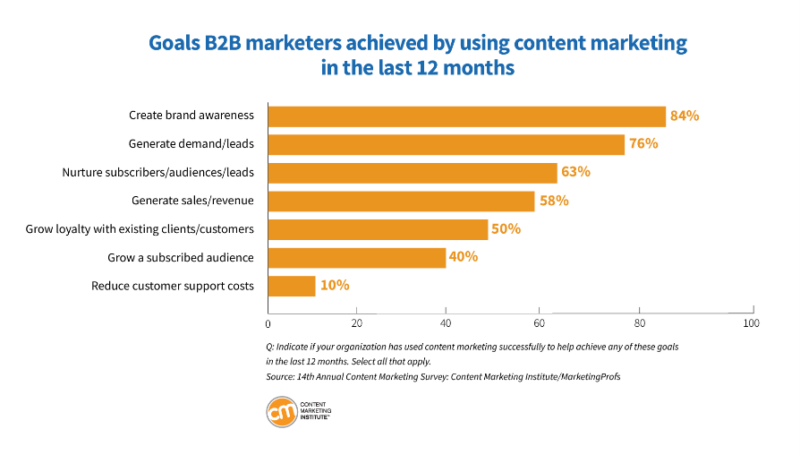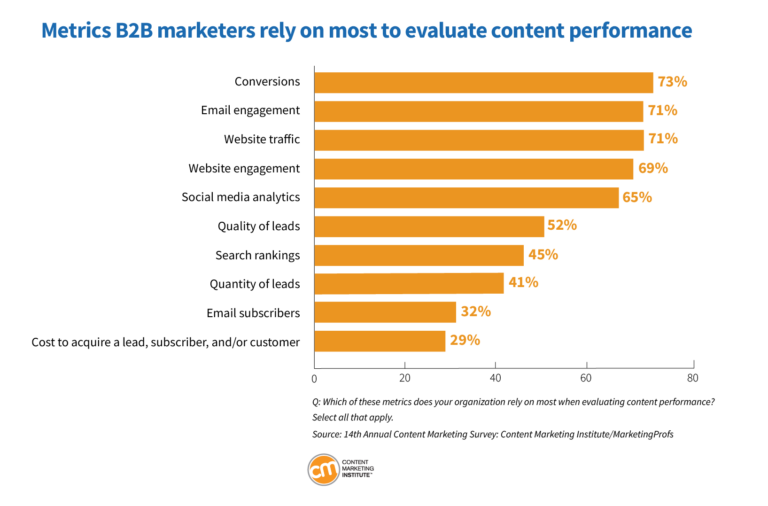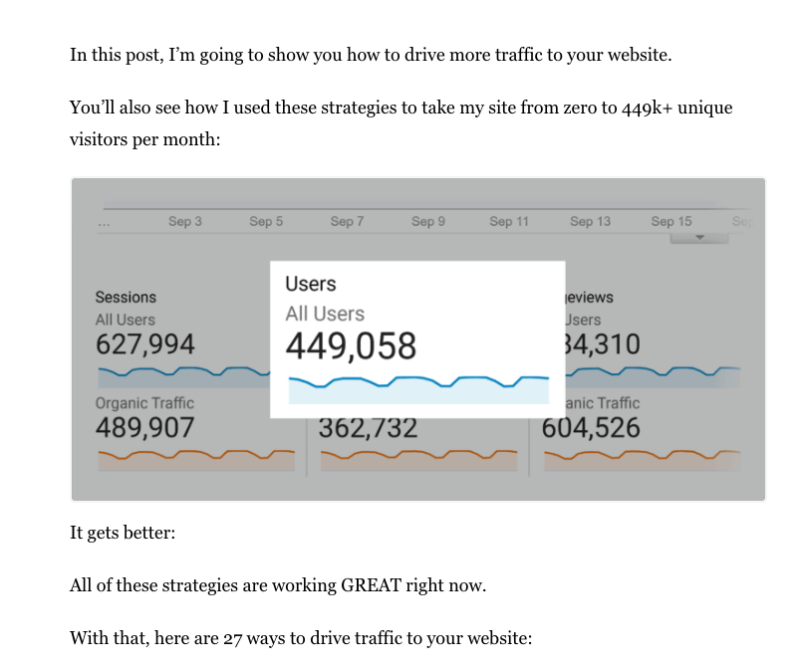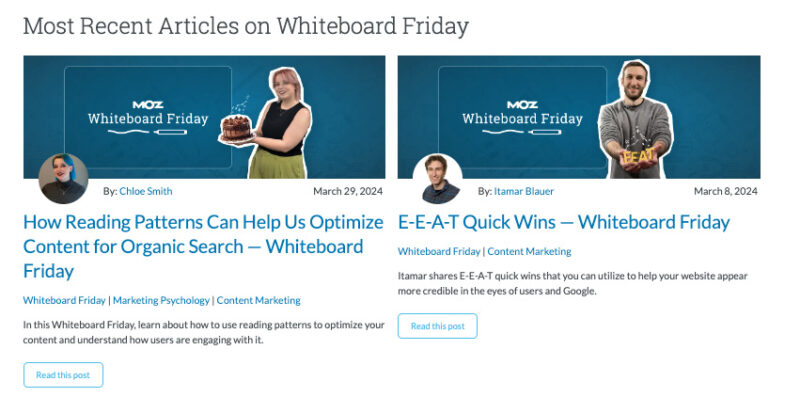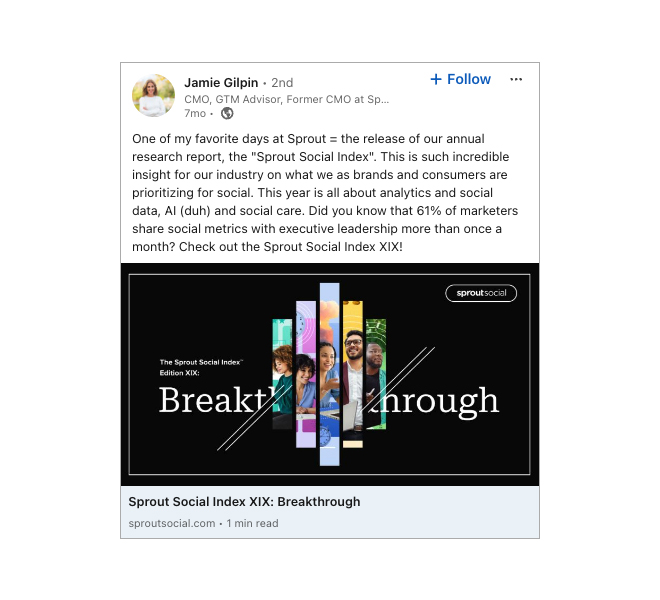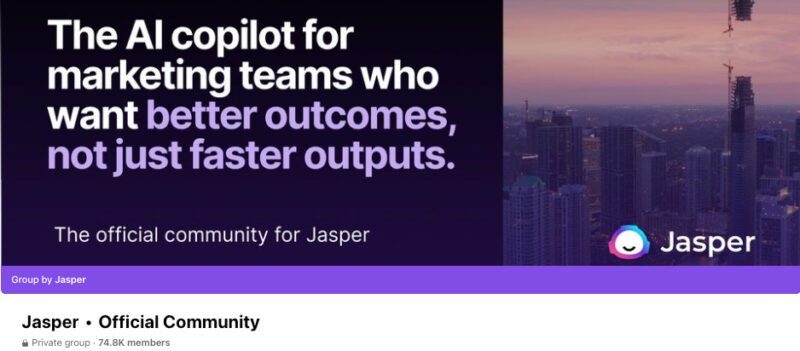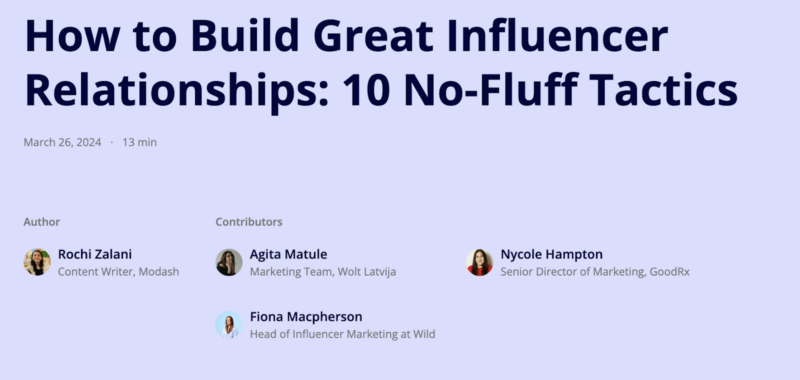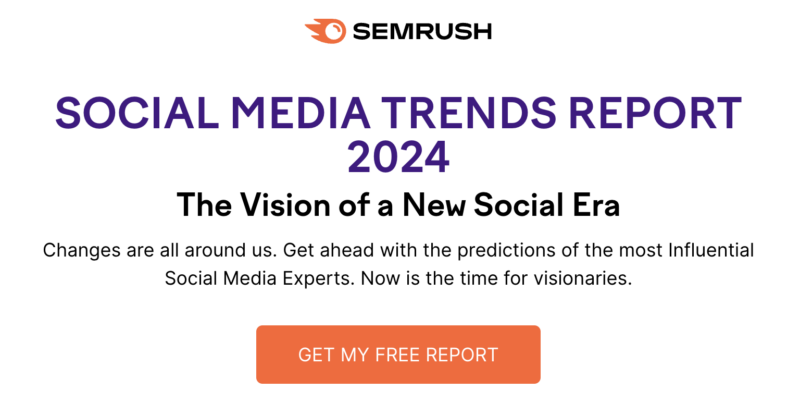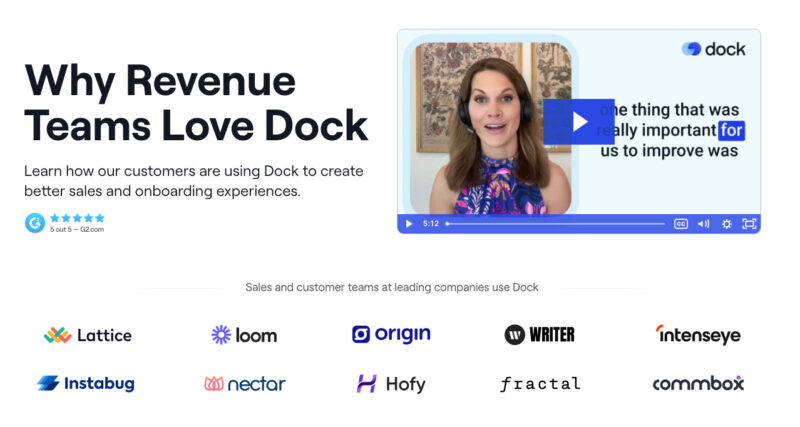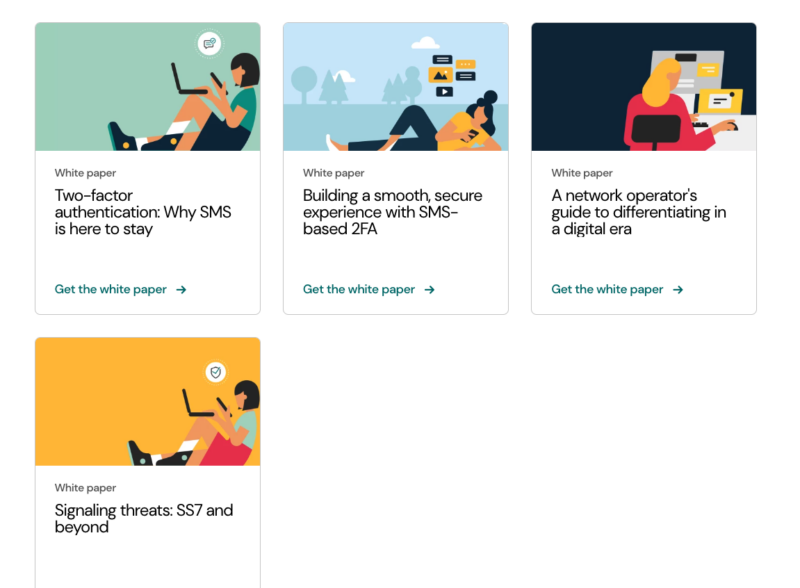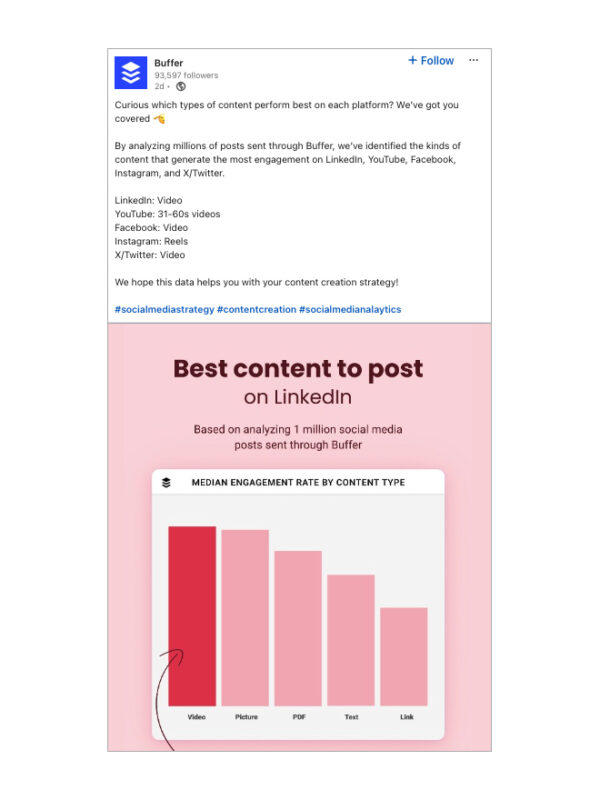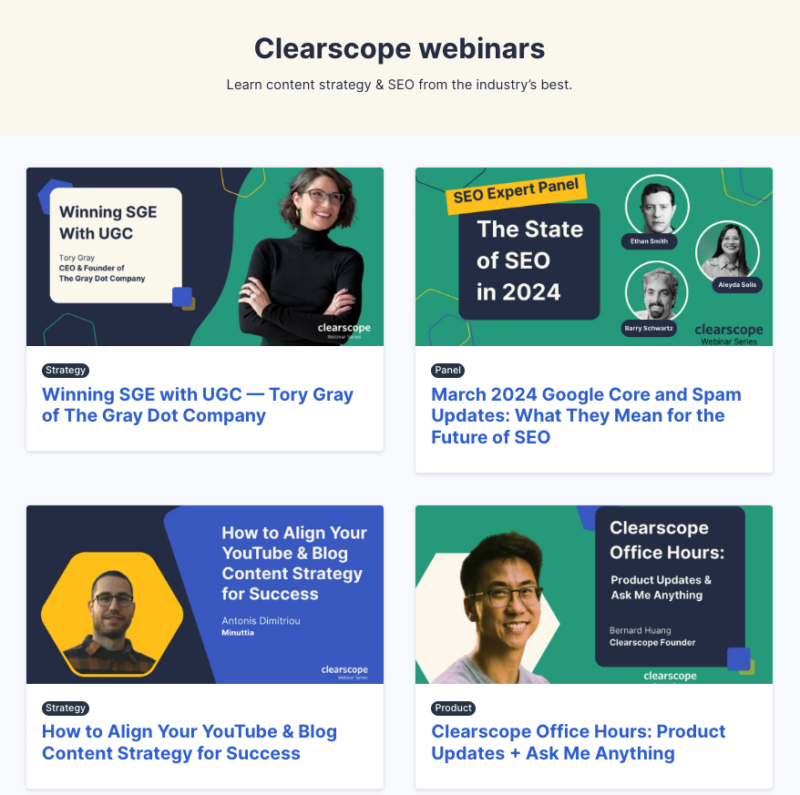The Advanced Guide to B2B Content Marketing

What do HubSpot, Drift, Arrow Electronics, SAP, WP Engine, Ahrefs, and NextView Ventures have in common?
All of them use content marketing to grow their businesses.
Business-to-business (B2B) verticals are becoming more crowded and competitive. B2B content marketing can be your secret weapon for differentiated marketing, building your brand, increasing visibility, attracting traffic, driving leads, and ultimately increasing revenue.
In this guide to B2B content marketing, we will discuss why content marketing is so valuable for B2B brands, how to develop a strategy, and what types of content to create.
What is B2B Content Marketing
B2B vs. B2C Content Marketing
Why B2B Content Marketing is Important
How to Develop a B2B Content Marketing Strategy

The ROI of Blogging in 2024
Read the PostEstablish Key Performance Indicators (KPIs)
KPIs measure your content’s efficiency in achieving its key goals. Almost half of B2B marketers agree their organization measures content marketing success. Here’s a breakdown of what they measure:
But measuring every KPI is like throwing spaghetti at the wall — overwhelming and useless. Instead, focus on the metrics that matter most to your goals.
Trying to establish thought leadership? Track share of voice, brand mentions, and earned media placements. Aiming for lead generation? Monitor form submissions, content downloads, and MQLs.
Even better: align your KPIs with the buyer’s journey:
- Top of Funnel: Brand awareness, site traffic, social engagement
- Middle of Funnel: Lead generation, form fills, content downloads
- Bottom of Funnel: Sales qualified leads, pipeline revenue, closed/won deals
The key is quality over quantity. Don’t just chase vanity metrics. Measure what moves the needle for your business.
Define Audience Segments and Buyer Personas
Start by identifying your key audience segments. Maybe they’re marketing managers, sales directors, and C-suite executives, or small business owners, enterprise decision-makers, and technical users.
Then, create buyer personas for each segment. These detailed profiles capture buyers’ goals, challenges, and preferences.
Include info like:
- Job title and responsibilities
- Company size and industry
- Biggest pain points and priorities
- Preferred content formats and channels
- Psychological needs and motivators
That last one is key. HBR found that B2B buyers prioritize interactions that fuel their psychological needs — even if they require more time or money.
So don’t just focus on demographics. Dig into their emotional drivers. Do they crave confidence, pride, or excitement? Craft content that speaks to those desires.
Personas help you create content that resonates on a deeper level. Instead of generic content, you’ll deliver targeted insights that address your audience’s specific challenges. Take the time to truly understand your audience. Interview customers, analyze data, and collaborate with sales. The more you know, the more impactful your content is.
Determine the Specific Questions Going through Their Minds
Know what’s on your audience’s mind at each stage of the funnel to create content that converts.
In the awareness stage, they’re asking high-level questions like:
- What is [problem/opportunity]?
- Why is [problem/opportunity] important?
- How do I know if I have [problem/opportunity]?
In the consideration stage, they’re evaluating potential solutions:
- What are the different approaches to solving [problem]?
- What are the pros and cons of each approach?
- How do I choose the right solution for my needs?
In the decision stage, they’re comparing specific vendors:
- How does [your product] compare to [competitor]?
- What are the implementation and onboarding processes like?
- What ROI can I expect from [your product]?
To uncover these questions, start with keyword research. Look at Google’s “People Also Ask” results. Use tools like Thruuu or Answer the Public to find common search queries.
Then, create content that addresses these questions head-on. In the awareness stage, focus on educational blog posts and guides. In consideration, provide comparison guides and case studies. In decision, offer product demos and ROI calculators.
Meet your audience where they are with the right content at the right time. Answer their burning questions to build trust, establish authority, and guide them through the funnel.
Determine Your Content Value Proposition
Your content value prop is your North Star. It guides every blog post, every video, and every social update. Nail it, and you’ll cut through the clutter and connect with your audience on a deeper level.
Take Backlinko, for example. They could churn out the same old SEO advice as everyone else. Instead, they differentiate through:
- In-depth, data-driven case studies
- Engaging, personality-packed videos
- Proprietary frameworks and coined terms
Here’s an example of what this looks like in action:
That’s their content value prop: Insider SEO secrets you won’t find anywhere else, presented in a fresh, entertaining way.
What’s yours? Maybe it’s:
- Unfiltered, behind-the-scenes looks at your company
- Bold, contrarian takes on industry trends
- Stunning, scroll-stopping visual content
The key is to find your unique angle. What can you offer that no one else can? What’s your unfair advantage?
Dig deep into your brand DNA. What are your core values and differentiators? Infuse those into every piece of content.
Be Creative
Let’s talk numbers: 7.5 million blog posts are published every day. It can be challenging to differentiate yourself with so much clutter. Creativity is essential for this reason.
Just look at the data from Sprout Social: 72% of consumers expect brands to be positive contributors to society. 64% want brands to connect with them and use their power to help people. Cookie-cutter content won’t cut it.
Instead, introduce creative campaigns that break the mold. Consider Moz’s “Whiteboard Friday” video series. Instead of dry SEO lectures, they feature lively, hand-drawn explanations that make complex topics accessible.
It’s a prime example of how a unique format can set you apart.
The lesson? Creativity is your competitive edge. Producing content isn’t enough — you must innovate, take risks, and deliver unique experiences.
Create Evergreen Content
“Evergreen” content is always relevant and helpful, no matter when it’s published or read. Creating outstanding content requires much time and effort, so you should publish as much evergreen content as possible.
Here’s an evergreen content example from Semrush:
You want much of your content library to be evergreen so you can continue to benefit from it long after it’s published. That’s how you build content that compounds.
Evergreen content covers topics that matter months or years from now. Rather than always trying to follow the latest trend, identify key topics that will continue to be at the heart of your audience’s pain points, interests, and challenges. Then, plan content around these topics so your content library is always relevant.
Develop Content Ideas and a Content Calendar
Once you’ve developed your B2B content marketing goals and buyer personas, you need to develop content ideas. Consider these when choosing what content to prioritize:
- Topic
- SEO keywords
- Author
- Target audience segment and persona
- Location in the customer journey
- Content format
- Publication and consumption channels
- Timing (For example, content focused on “trends” performs best at the end or beginning of the year.)
- Desired outcome and CTAs
Create content around topics relevant to your target audience in formats and locations that help you achieve your content marketing goals. Make sure your content adds value to your audience.
After developing your content ideas, map those ideas to a content calendar. You should include milestones for creating and publishing each piece of content and who’s responsible for what. This planning ensures a regular publishing schedule.
Use Search Engine Optimization (SEO)
High-quality content is your ticket to better B2B SEO results, such as greater organic traffic and leads. But even if your goal isn’t specifically more organic search traffic, you need to optimize a good percentage of your content for search engines.
SEO helps you align your content with your audience’s interests. Optimizing content for organic search requires:
- Doing topic and keyword research to determine what potential customers are searching for at each stage of the customer journey
- Creating high-value content that is optimized for primary, related, and long-tail keywords
- Using a straightforward, easy-to-navigate website architecture so both Google and users can understand how different pages are related to each other
The more you integrate SEO into your B2B content marketing strategy, the better the results your content will achieve.

Major SEO Trends to Know in 2024
Read the PostBuild Trust
Your content is your most powerful trust-building tool. Every blog post, every video, every social update is a chance to prove your credibility and expertise.
How?
- Deliver exceptional value. Don’t just scratch the surface — dive deep into your audience’s challenges and provide actionable solutions. Show them you understand their world and are uniquely equipped to help.
- Showcase customer success stories. Nothing builds trust like real-world results. Share detailed case studies that highlight the tangible impact of your product or service.
- Use user-generated content. Encourage customers to share their experiences on social media platforms or in testimonials. Authentic, third-party validation carries serious weight.
- Be transparent. Discuss your product’s limitations or your company’s missteps. Honesty and vulnerability go a long way toward building trust.
Finally, flaunt your authority. Feature logos of prominent publications you’ve been featured in, like Forbes or TechCrunch, highlighting your team’s credentials and accolades.
Make sure your content consistently shows your value, integrity, and expertise.
Content Atomization & Repurposing
Content atomization is breaking a larger piece of content into smaller, standalone chunks and repurposing those chunks across multiple channels.
Let’s say you have a meaty blog post. You could:
- Pull out key stats and quotes for social media posts
- Transform a section into an infographic or SlideShare deck
- Repackage the main points into a short video or podcast episode
Sprout Social has mastered this process. When they release their annual Sprout Index, they atomize it into:
- A series of blog posts diving deep into specific findings
- An email drip campaign delivering the highlights to inboxes
- Bite-sized social posts featuring compelling data points
They maximize the report’s reach and engagement across channels by breaking it into smaller pieces.
The beauty of atomization? It allows you to get way more mileage from every piece of content. You work hard to create it — might as well make sure it gets seen by as many people as possible, in whatever format they prefer.
Build a Community
Topic-based communities bring your audience together to discuss challenges, share insights, and get real-time answers to burning questions.
Take Jasper AI. They’ve built a thriving Facebook community of over 70k marketers and entrepreneurs. Members share use cases, swap tips, and even co-create content.
The result? Unparalleled engagement, loyalty, and advocacy. Jasper’s community has become a powerful customer acquisition, retention, and growth engine.
Building your own community doesn’t have to be daunting. Start small with a focused niche. Use platforms like Slack, Discord, or Facebook Groups to host discussions.
Then, seed the conversation with valuable content. Share blog posts, whitepapers, and webinars. But also encourage members to contribute their own insights and experiences.
Over time, your community will take on a life of its own. Members will form connections, collaborations, and even friendships. They’ll become your biggest cheerleaders and champions.
Content Distribution
Your goal is to get your content in front of as many people within your target audience as possible. There are three main types of distribution channels:
- Owned Media
- Your website (blog, resource center, product pages)
- Your social media profiles
- Your email list
- Earned Media
- Guest posts on industry blogs
- Media coverage and press mentions
- Organic social shares and user-generated content
- Paid Media
- Sponsored content on relevant websites
- Social media ads targeted to your ideal audience
- Influencer partnerships and sponsorships
The key is to mix all three to maximize reach and impact.
Start with your owned channels. Optimize your website for search, making it easy for prospects to discover your content. Build your email list and nurture subscribers with valuable insights.
Then, expand to earned media. Contribute guest posts to publications your audience trusts. Encourage happy customers to share their experiences on social.
Finally, amplify with paid media. Use LinkedIn ads to target decision-makers by job title and company size — partner with influencers to reach new audiences with your content.
The most effective B2B content distribution strategies are multi-channel and targeted. They meet buyers where they are.
Types of Content for B2B Content Marketing

The Stratabeat Playbook: 4 Ways to Drive Major Traffic Increases for Your B2B Website
Read the PostEmail Marketing
Despite being around for 25+ years, email marketing is still a powerful channel. For software and technology businesses, for example, Litmus found the ROI is as high as 36:1. Your B2B content marketing strategy can take advantage of email marketing in several ways:
- Sending automated nurture sequences to new leads
- Sharing new content with current subscribers
- Giving product/service updates
- Offering discounts or promotions
- Answering questions from potential customers
Email marketing works best with other marketing channels, such as your website. Your website is one of the primary places where you capture new leads’ email addresses, as CoSchedule does while promoting research.
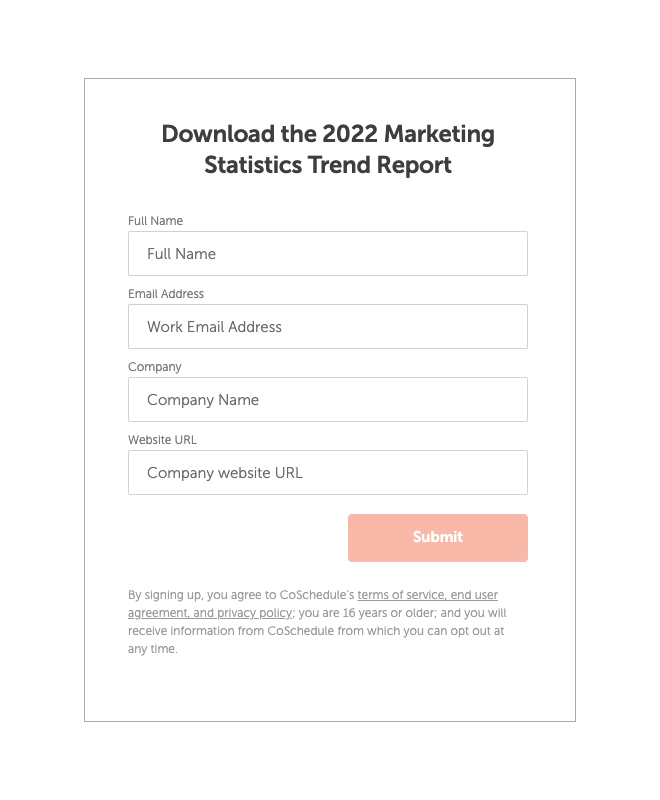
Then, you use email marketing to direct those new leads back to relevant pages and content on your site.
Infographics
Infographics combine data, design, and storytelling to make your message memorable.
The beauty of infographics is that they’re highly shareable. People love to post them on social media, embed them in blog posts, and even print them out for reference. That means more eyeballs on your brand, which is why they’re great for the awareness stage.
But creating a great infographic isn’t just about pretty pictures. Take Omnisend’s infographic as an example.
It starts with solid data and a clear message. The design includes bold visuals, concise text, and a logical flow, making it easy to grasp at a glance.
Podcasts
Podcasts have exploded in popularity, and for good reason. They allow you to dive deep into a topic while your audience multitasks — commuting, exercising, you name it. It’s the perfect format for the awareness stage. You can educate, entertain, and inspire potential customers before they even know they need your product.
Take Superpath. Their B2B content strategy podcast, “Content, Briefly,” has become a go-to resource for content marketers. By sharing expert insights and actionable tips, they’ve built a loyal following and established their authority.
Superpath also collaborates with reputable guests who can share unique perspectives and practical advice.
With podcasts, consistency is crucial. Commit to a regular publishing schedule — whether that’s weekly, biweekly, or monthly. Give your audience something to look forward to.
Podcasting is a powerful way to build relationships with your B2B audience. It’s personal, engaging, and perfect for on-the-go consumption.
Long and Short-Form Video Content
From in-depth webinars to snackable social clips, video allows you to connect with your audience in a way that text and images simply can’t.
Take webinars, for example. These long-form, interactive sessions are perfect for exploring complex topics and establishing expertise.
Look at Clearscope — their SEO webinars are a go-to resource for content marketers looking to level up their skills.
But not every video needs to be a 60-minute masterclass. Short-form content, like Instagram Reels and TikTok videos, can be as impactful. These bite-sized clips showcase your brand’s personality, share quick tips, and jump on trending topics.
Match the format to the message. Have a meaty subject that requires a lot of context? Go with a webinar or tutorial. Want to share a quick insight or behind-the-scenes moment? A short-form clip is your best bet.
No matter the length, the most effective B2B videos are engaging, informative, and authentic. They give your audience a reason to tune in — and keep coming back for more.
Online Calculators and Tools
Interactive content, such as free tools and calculators, engages your B2B audience and generates leads.
Free tools and calculators are a great way to attract new leads, demonstrate your expertise, and build backlinks.
For example, HubSpot has numerous free marketing tools, including a website grader, persona creator, and blog ideas generator.
CoSchedule also has a free headline analyzer that helps people develop better blog post headlines.
That page alone ranks for almost 900 keywords, generating over 25,000 backlinks.
Can you create (or hire someone to build) a free, valuable tool for your website? If so, use it to drive organic traffic and backlinks to your site.
